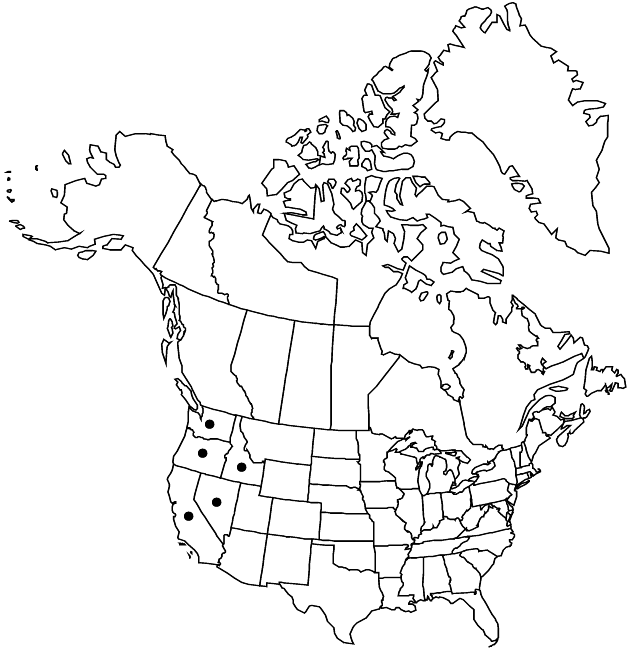Difference between revisions of "Psilocarphus oregonus"
Trans. Amer. Philos. Soc., n. s. 7: 341. 1840.
FNA>Volume Importer |
FNA>Volume Importer |
||
| Line 24: | Line 24: | ||
|elevation=10–1800(–2400) m | |elevation=10–1800(–2400) m | ||
|distribution=Calif.;Idaho;Nev.;Oreg.;Wash. | |distribution=Calif.;Idaho;Nev.;Oreg.;Wash. | ||
| − | |discussion=<p>Psilocarphus oregonus occurs from west-central California through most of Oregon to southeastern Washington, western Idaho, and northern Nevada. Relatively narrow-leaved, montane forms of P. tenellus account for reports of P. oregonus from the southern Sierra Nevada to Baja California; further study may show these to be intermediates between the two taxa.</p><!-- | + | |discussion=<p><i>Psilocarphus oregonus</i> occurs from west-central California through most of Oregon to southeastern Washington, western Idaho, and northern <i>Nevada</i>. Relatively narrow-leaved, montane forms of <i>P. tenellus</i> account for reports of <i>P. oregonus</i> from the southern Sierra <i>Nevada</i> to Baja California; further study may show these to be intermediates between the two taxa.</p><!-- |
| − | --><p>A malformed plant collected in Merced County, California, appears to have been a sterile hybrid between P. oregonus and Hesperevax caulescens (J. D. Morefield 1992c).</p> | + | --><p>A malformed plant collected in Merced County, California, appears to have been a sterile hybrid between <i>P. oregonus</i> and <i>Hesperevax caulescens</i> (J. D. Morefield 1992c).</p> |
|tables= | |tables= | ||
|references= | |references= | ||
| Line 49: | Line 49: | ||
|publication year=1840 | |publication year=1840 | ||
|special status= | |special status= | ||
| − | |source xml=https://jpend@bitbucket.org/aafc-mbb/fna-data-curation.git/src/ | + | |source xml=https://jpend@bitbucket.org/aafc-mbb/fna-data-curation.git/src/8f726806613d60c220dc4493de13607dd3150896/coarse_grained_fna_xml/V19-20-21/V19_763.xml |
|tribe=Asteraceae tribe Gnaphalieae | |tribe=Asteraceae tribe Gnaphalieae | ||
|genus=Psilocarphus | |genus=Psilocarphus | ||
Revision as of 15:14, 18 September 2019
Plants silvery to whitish, densely sericeous to somewhat lanuginose. Stems (1–)2–10, ascending to ± prostrate; proximal internode lengths mostly 0.5–1.5(–2) times leaf lengths. Capitular leaves ± erect, appressed to heads, linear to narrowly oblanceolate, widest in distal 2/3, longest 12–20 mm, lengths mostly 6–12 times widths, (3–)3.5–5 times head heights. Heads ± spheric, largest 4–6 mm. Receptacles unlobed. Pistillate paleae individually visible through indument, longest mostly 1.5–2.7 mm. Staminate corollas 0.7–1.4 mm, lobes mostly 4. Cypselae narrowly ± cylindric, terete, 0.6–1.2 mm.
Phenology: Flowering and fruiting late Mar–mid Aug.
Habitat: Seasonally inundated or flooded clay soils (vernal pool margins, drainages, moist rocky slopes)
Elevation: 10–1800(–2400) m
Distribution

Calif., Idaho, Nev., Oreg., Wash.
Discussion
Psilocarphus oregonus occurs from west-central California through most of Oregon to southeastern Washington, western Idaho, and northern Nevada. Relatively narrow-leaved, montane forms of P. tenellus account for reports of P. oregonus from the southern Sierra Nevada to Baja California; further study may show these to be intermediates between the two taxa.
A malformed plant collected in Merced County, California, appears to have been a sterile hybrid between P. oregonus and Hesperevax caulescens (J. D. Morefield 1992c).
Selected References
None.